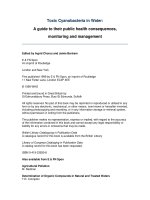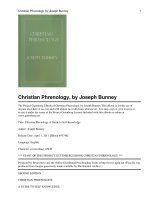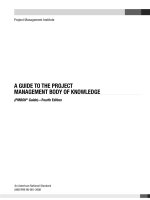sensitivity analysis in practice a guide to assessing scientific models
Bạn đang xem bản rút gọn của tài liệu. Xem và tải ngay bản đầy đủ của tài liệu tại đây (3.29 MB, 232 trang )
SENSITIVITY ANALYSIS IN PRACTICE
SENSITIVITY ANALYSIS
IN PRACTICE
A GUIDE TO ASSESSING
SCIENTIFIC MODELS
Andrea Saltelli, Stefano Tarantola,
Francesca Campolongo and Marco Ratto
Joint Research Centre of the European Commission, Ispra, Italy
Copyright
C
2004 John Wiley & Sons Ltd, The Atrium, Southern Gate, Chichester,
West Sussex PO19 8SQ, England
Telephone (+44) 1243 779777
Email (for orders and customer service enquiries):
Visit our Home Page on www.wileyeurope.com or www.wiley.com
All Rights Reserved. No part of this publication may be reproduced, stored in a retrieval system
or transmitted in any form or by any means, electronic, mechanical, photocopying, recording,
scanning or otherwise, except under the terms of the Copyright, Designs and Patents Act 1988
or under the terms of a licence issued by the Copyright Licensing Agency Ltd, 90 Tottenham
Court Road, London W1T 4LP, UK, without the permission in writing of the Publisher.
Requests to the Publisher should be addressed to the Permissions Department, John Wiley &
Sons Ltd, The Atrium, Southern Gate, Chichester, West Sussex PO19 8SQ, England, or emailed
to , or faxed to (+44) 1243 770571.
This publication is designed to provide accurate and authoritative information in regard to
the subject matter covered. It is sold on the understanding that the Publisher is not engaged
in rendering professional services. If professional advice or other expert assistance is
required, the services of a competent professional should be sought.
Other Wiley Editorial Offices
John Wiley & Sons Inc., 111 River Street, Hoboken, NJ 07030, USA
Jossey-Bass, 989 Market Street, San Francisco, CA 94103-1741, USA
Wiley-VCH Verlag GmbH, Boschstr. 12, D-69469 Weinheim, Germany
John Wiley & Sons Australia Ltd, 33 Park Road, Milton, Queensland 4064, Australia
John Wiley & Sons (Asia) Pte Ltd, 2 Clementi Loop #02-01, Jin Xing Distripark,
Singapore 129809
John Wiley & Sons Canada Ltd, 22 Worcester Road, Etobicoke, Ontario, Canada M9W 1L1
Wiley also publishes its books in a variety of electronic formats. Some content that appears
in print may not be available in electronic books.
Library of Congress Cataloging-in-Publication Data
Sensitivity analysis in practice : a guide to assessing scientific
models / Andrea Saltelli [et al.].
p. cm.
Includes bibliographical references and index.
ISBN 0-470-87093-1 (cloth : alk. paper)
1. Sensitivity theory (Mathematics)—Simulation methods. 2. SIMLAB.
I. Saltelli, A. (Andrea), 1953–
QA402.3 .S453 2004
003
.5—dc22 2003021209
British Library Cataloguing in Publication Data
A catalogue record for this book is available from the British Library
ISBN 0-470-87093-1
EUR 20859 EN
Typeset in 12/14pt Sabon by TechBooks, New Delhi, India
Printed and bound in Great Britain
This book is printed on acid-free paper responsibly manufactured from sustainable forestry
in which at least two trees are planted for each one used for paper production.
CONTENTS
PREFACE
ix
1 A WORKED EXAMPLE 1
1.1 A simple model 1
1.2 Modulus version of the simple model 10
1.3 Six-factor version of the simple model 15
1.4 The simple model ‘by groups’ 22
1.5 The (less) simple correlated-input model 25
1.6 Conclusions 28
2 GLOBAL SENSITIVITY ANALYSIS FOR
IMPORTANCE ASSESSMENT 31
2.1 Examples at a glance 31
2.2 What is sensitivity analysis? 42
2.3 Properties of an ideal sensitivity analysis method 47
2.4 Defensible settings for sensitivity analysis 49
2.5 Caveats 56
3 TEST CASES 63
3.1 The jumping man. Applying variance-based methods 63
3.2 Handling the risk of a financial portfolio: the problem of
hedging. Applying Monte Carlo filtering and variance-based
methods 66
3.3 A model of fish population dynamics. Applying
the method of Morris 71
3.4 The Level E model. Radionuclide migration in the geosphere.
Applying variance-based methods and Monte Carlo filtering 77
3.5 Two spheres. Applying variance based methods in
estimation/calibration problems 83
3.6 A chemical experiment. Applying variance based methods in
estimation/calibration problems 85
3.7 An analytical example. Applying the method of Morris 88
vi CONTENTS
4 THE SCREENING EXERCISE 91
4.1 Introduction 91
4.2 The method of Morris 94
4.3 Implementing the method 100
4.4 Putting the method to work: an analytical example 103
4.5 Putting the method to work: sensitivity analysis
of a fish population model 104
4.6 Conclusions 107
5 METHODS BASED ON DECOMPOSING THE
VARIANCE OF THE OUTPUT 109
5.1 The settings 109
5.2 Factors Prioritisation Setting 110
5.3 First-order effects and interactions 111
5.4 Application of S
i
to Setting ‘Factors Prioritisation’ 112
5.5 More on variance decompositions 118
5.6 Factors Fixing (FF) Setting 120
5.7 Variance Cutting (VC) Setting 121
5.8 Properties of the variance based methods 123
5.9 How to compute the sensitivity indices: the case
of orthogonal input 124
5.9.1 A digression on the Fourier Amplitude Sensitivity
Test (FAST) 132
5.10 How to compute the sensitivity indices: the case
of non-orthogonal input 132
5.11 Putting the method to work: the Level E model 136
5.11.1 Case of orthogonal input factors 137
5.11.2 Case of correlated input factors 144
5.12 Putting the method to work: the bungee jumping model 145
5.13 Caveats 148
6 SENSITIVITY ANALYSIS IN DIAGNOSTIC
MODELLING: MONTE CARLO FILTERING AND
REGIONALISED SENSITIVITY ANALYSIS,
BAYESIAN UNCERTAINTY ESTIMATION AND
GLOBAL SENSITIVITY ANALYSIS 151
6.1 Model calibration and Factors Mapping Setting 151
6.2 Monte Carlo filtering and regionalised sensitivity analysis 153
6.2.1 Caveats 155
6.3 Putting MC filtering and RSA to work: the problem of
hedging a financial portfolio 161
6.4 Putting MC filtering and RSA to work:
the Level E test case 167
Contents vii
6.5 Bayesian uncertainty estimation and global
sensitivity analysis 170
6.5.1 Bayesian uncertainty estimation 170
6.5.2 The GLUE case 173
6.5.3 Using global sensitivity analysis in the Bayesian
uncertainty estimation 175
6.5.4 Implementation of the method 178
6.6 Putting Bayesian analysis and global SA to work:
two spheres 178
6.7 Putting Bayesian analysis and global SA to work:
a chemical experiment 184
6.7.1 Bayesian uncertainty analysis (GLUE case) 185
6.7.2 Global sensitivity analysis 185
6.7.3 Correlation analysis 188
6.7.4 Further analysis by varying temperature in the data
set: fewer interactions in the model 189
6.8 Caveats 191
7 HOW TO USE SIMLAB 193
7.1 Introduction 193
7.2 How to obtain and install SIMLAB 194
7.3 SIMLAB main panel 194
7.4 Sample generation 197
7.4.1 FAST 198
7.4.2 Fixed sampling 198
7.4.3 Latin hypercube sampling (LHS) 198
7.4.4 The method of Morris 199
7.4.5 Quasi-Random LpTau 199
7.4.6 Random 200
7.4.7 Replicated Latin Hypercube (r-LHS) 200
7.4.8 The method of Sobol’ 200
7.4.9 How to induce dependencies in the input factors 200
7.5 How to execute models 201
7.6 Sensitivity analysis 202
8 FAMOUS QUOTES: SENSITIVITY ANALYSIS IN
THE SCIENTIFIC DISCOURSE 205
REFERENCES 211
INDEX 217
PREFACE
This book is a ‘primer’ in global sensitivity analysis (SA). Its am-
bition is to enable the reader to apply global SA to a mathematical
or computational model. It offers a description of a few selected
techniques for sensitivity analysis, used for assessing the relative
importance of model input factors. These techniques will answer
questions of the type ‘which of the uncertain input factors is more
important in determining the uncertainty in the output of interest?’
or ‘if we could eliminate the uncertainty in one of the input factors,
which factor should we choose to reduce the most the variance of
the output?’ Throughout this primer, the input factors of interest
will be those that are uncertain, i.e. whose value lie within a finite
interval of non-zero width. As a result, the reader will not find
sensitivity analysis methods here that look at the local property of
the input–output relationships, such as derivative-based analysis
1
.
Special attention is paid to the selection of the method, to the fram-
ing of the analysis and to the interpretation and presentation of the
results. The examples will help the reader to apply the methods in a
way that is unambiguous and justifiable, so as to make the sensitiv-
ity analysis an added value to model-based studies or assessments.
Both diagnostic and prognostic uses of models will be considered
(a description of these is in Chapter 2), and Bayesian tools of anal-
ysis will be applied in conjunction with sensitivity analysis. When
discussing sensitivity with respect to factors, we shall interpret the
term ‘factor’ in a very broad sense: a factor is anything that can be
changed in a model prior to its execution. This also includes struc-
tural or epistemic sources of uncertainty. To make an example,
factors will be presented in applications that are in fact ‘triggers’,
used to select one model structure versus another, one mesh size ver-
sus another, or altogether different conceptualisations of a system.
1
A cursory exception is in Chapter 1.
x Preface
Often, models use multi-dimensional uncertain parameters and/or
input data to define the geographically distributed properties of a
natural system. In such cases, a reduced set of scalar factors has
to be identified in order to characterise the multi-dimensional un-
certainty in a condensed, but exhaustive fashion. Factors will be
sampled either from their prior distribution, or from their posterior
distribution, if this is available. The main methods that we present
in this primer are all related to one another and are the method of
Morris for factors’ screening and variance-based measures
2
. Also
touched upon are Monte Carlo filtering in conjunction with either
a variance based method or a simple two-sample test such as the
Smirnov test. All methods used in this book are model-free, in the
sense that their application does not rely on special assumptions
on the behaviour of the model (such as linearity, monotonicity
and additivity of the relationship between input factors and model
output).
The reader is encouraged to replicate the test cases offered
in this book before trying the methods on the model of inter-
est. To this effect, the SIMLAB software for sensitivity analy-
sis is offered. It is available free on the Web-page of this book
Also available at the
same URL are a set of scripts in MATLAB
r
and the GLUEWIN
software that implements a combination of global sensitivity anal-
ysis, Monte Carlo filtering and Bayesian uncertainty estimation.
This book is organised as follows. The first chapter presents the
reader with most of the main concepts of the book, through their
application to a simple example, and offers boxes with recipes
to replicate the example using SIMLAB. All the concepts will
then be revisited in the subsequent chapters. In Chapter 2 we
offer another preview of the contents of the book, introducing
succinctly the examples and their role in the primer. Chapter 2
also gives some definitions of the subject matter and ideas about
the framing of the sensitivity analysis in relation to the defensi-
bility of model-based assessment. Chapter 3 gives a full descrip-
tion of the test cases. Chapter 4 tackles screening methods for
2
Variance based measures are generally estimated numerically using either the method of Sobol’
or FAST (Fourier Analysis Sensitivity Test), or extensions of these methods available in the
SIMLAB software that comes with this primer.
Preface xi
sensitivity analysis, and in particular the method of Morris, with
applications. Chapter 5 discusses variance based measures, with
applications. More ideas about ‘setting for the analysis’ are pre-
sented here. Chapter 6 covers Bayesian uncertainty estimation and
Monte Carlo filtering, with emphasis on the links with global sen-
sitivity analysis. Chapter 7 gives some instructions on how to use
SIMLAB and, finally, Chapter 8 gives a few concepts and some
opinions of various practitioners about SA and its implication for
an epistemology of model use in the scientific discourse.
1A WORKED EXAMPLE
This chapter presents an exhaustive analysis of a simple example,
in order to give the reader a first overall view of the problems met
in quantitative sensitivity analysis and the methods used to solve
them. In the following chapters the same problems, questions, and
techniques will be presented in full detail.
We start with a sensitivity analysis for a mathematical model in
its simplest form, and work it out adding complications to it one
at a time. By this process the reader will meet sensitivity analysis
methods of increasing complexity, starting from the elementary
approaches to the more quantitative ones.
1.1 A simple model
A simple portfolio model is:
Y = C
s
P
s
+ C
t
P
t
+ C
j
P
j
(1.1)
where Y is the estimated risk
1
in €, C
s
, C
t
, C
j
are the quantities
per item, and P
s
, P
t
, P
j
are hedged portfolios in €.
2
This means
that each P
x
, x ={s, t, j} is composed of more than one item –
so that the average return P
x
is zero €. For instance, each hedged
portfolio could be composed of an option plus a certain amount
of underlying stock offsetting the option risk exposure due to
1
This is the common use of the term. Y is in fact a return. A negative uncertain value of Y is
what constitutes the risk.
2
This simple model could well be seen as a composite (or synthetic) indicator camp by aggre-
gating a set of standardised base indicators P
i
with weights C
i
(Tarantola et al., 2002; Saisana
and Tarantola, 2002).
Sensitivity Analysis in Practice: A Guide to Assessing Scientific Models A. Saltelli, S. Tarantola,
F. Campolongo and M. Ratto
C
2004 John Wiley & Sons, Ltd. ISBN 0-470-87093-1
2 A worked example Chap. 1
movements in the market stock price. Initially we assume
C
s
, C
t
, C
j
= constants. We also assume that an estimation pro-
cedure has generated the following distributions for P
s
, P
t
, P
j
:
P
s
∼ N
(
¯
p
s
,σ
s
)
,
¯
p
s
= 0,σ
s
= 4
P
t
∼ N
(
¯
p
t
,σ
t
)
,
¯
p
t
= 0,σ
t
= 2
P
j
∼ N
¯
p
j
,σ
j
,
¯
p
j
= 0,σ
j
= 1.
(1.2)
The P
x
s are assumed independent for the moment. As a result
of these assumptions, Y will also be normally distributed with
parameters
¯
y = C
s
¯
p
s
+ C
t
¯
p
t
+ C
j
¯
p
j
(1.3)
σ
y
=
C
2
s
σ
2
s
+ C
2
t
σ
2
t
+ C
2
j
σ
2
j
. (1.4)
Box 1.1 SIMLAB
The reader may want at this stage, or later in the study, to get
started with SIMLAB by reproducing the results (1.3)–(1.4).
This is in fact an uncertainty analysis, e.g. a characterisation
of the output distribution of Y given the uncertainties in its
input. The first thing to do is to input the factors P
s
, P
t
, P
j
with the distributions given in (1.2). This is done using the
left-most panel of SIMLAB (Figure 7.1), as follows:
1. Select ‘New Sample Generation’, then ‘Configure’, then
‘Create New’ when the new window ‘STATISTICAL PRE
PROCESSOR’ is displayed.
2. Select ‘Add’ from the input factor selection panel and add
factors one at a time as instructed by SIMLAB. Select ‘Ac-
cept factors’ when finished. This takes the reader back to
the ‘STATISTICAL PRE PROCESSOR’ window.
3. Select a sampling method. Enter ‘Random’ to start with,
and ‘Specify switches’ in the right. Enter something as a
seed for random number generation and the number of
executions (e.g. 1000). Create an output file by giving it a
name and selecting a directory.
A simple model 3
4. Go back to the left-most part of the SIMLAB main menu
and click on ‘Generate’. A sample is now available for the
simulation.
5. We now move to the middle of the panel (Model execution)
and select ‘Configure (Monte Carlo)’ and ‘Select Model’.
A new panel appears.
6. Select ‘Internal Model’ and ‘Create new’. A formula parser
appears. Enter the name of the output variable, e.g. ‘Y’ and
follow the SIMLAB formula editor to enter Equation (1.1)
with values of C
s
, C
t
, C
j
of choice.
7. Select ‘Start Monte Carlo’ from the main model panel. The
model is now executed the required number of times.
8. Move to the right-most panel of SIMLAB. Select ‘Anal-
yse UA/SA’, select ‘Y’ as the output variable as prompted;
choose the single time point option. This is to tell SIMLAB
that in this case the output is not a time series.
9. Click on UA. The figure on this page is produced. Click on
the square dot labelled ‘Y’ on the right of the figure and
read the mean and standard deviation of Y. You can now
compare these sample estimates with Equations (1.3–1.4).
4 A worked example Chap. 1
Let us initially assume that C
s
< C
t
< C
j
, i.e. we hold more
of the less volatile items (but we shall change this in the follow-
ing). A sensitivity analysis of this model should tell us something
about the relative importance of the uncertain factors in Equation
(1.1) in determining the output of interest Y, the risk from the
portfolio.
According to first intuition, as well as to most of the existing
literature on SA, the way to do this is by computing derivatives,
i.e.
S
d
x
=
∂Y
∂ P
x
, with x = s, t, j (1.5)
where the superscript ‘d’ has been added to remind us that this
measure is in principle dimensioned (∂Y/∂ P
x
is in fact dimension-
less, but ∂Y/∂C
x
would be in €). Computing S
d
x
for our model we
obtain
S
d
x
= C
x
, with x = s, t, j. (1.6)
If we use the S
d
x
s as our sensitivity measure, then the order of
importance of our factors is P
j
> P
t
> P
s
, based on the assumption
C
s
< C
t
< C
j
. S
d
x
gives us the increase in the output of interest Y
per unit increase in the factor P
x
. There seems to be something
wrong with this result: we have more items of portfolio j but this
is the one with the least volatility (it has the smallest standard
deviation, see Equation (1.2)). Even if σ
s
σ
t
,σ
j
, Equation (1.6)
would still indicate P
j
to be the most important factor, as Y would
be locally more sensitive to it than to either P
t
or P
s
.
Sometime local sensitivity measures are normalised by some ref-
erence or central value. If
y
0
= C
s
p
0
s
+ C
t
p
0
t
+ C
j
p
0
j
. (1.7)
then one can compute
S
l
x
=
p
0
x
y
0
∂Y
∂ P
x
, with x = s, t, j. (1.8)
A simple model 5
Applying this to our model, Equation (1.1), one obtains:
S
l
x
= C
x
p
0
x
y
0
, with x = s, t, j. (1.9)
In this case the order of importance of the factors depends on
the relative value of the C
x
s weighted by the reference values p
0
x
s.
The superscript ‘l ’ indicates that this index can be written as a
logarithmic ratio if the derivative is computed in p
0
x
.
S
l
x
=
p
0
x
y
0
∂Y
∂ P
x
y
0
, p
0
x
=
∂ ln
(
Y
)
∂ ln
(
P
x
)
y
0
, p
0
x
. (1.10)
S
l
x
gives the fractional increase in Y corresponding to a unit frac-
tional increase in P
x
. Note that the reference point p
0
s
, p
0
t
, p
0
j
might be made to coincide with the vector of the mean val-
ues
¯
p
s
,
¯
p
t
,
¯
p
j
, though this would not in general guarantee that
¯
y = Y(
¯
p
s
,
¯
p
t
,
¯
p
j
), even though this is now the case (Equation
(1.3)). Since
¯
p
s
,
¯
p
t
,
¯
p
j
= 0 and
¯
y = 0, S
l
x
collapses to be identical
to S
d
x
.
Also S
l
x
is insensitive to the factors’ standard deviations. It seems
a better measure of importance than S
d
x
, as it takes away the di-
mensions and is normalised, but it still offers little guidance as
to how the uncertainty in Y depends upon the uncertainty in the
P
x
s.
A first step in the direction of characterising uncertainty is a nor-
malisation of the derivatives by the factors’ standard deviations:
S
σ
s
=
σ
s
σ
y
∂Y
∂ P
s
= C
s
σ
s
σ
y
S
σ
t
=
σ
t
σ
y
∂Y
∂ P
t
= C
t
σ
t
σ
y
(1.11)
S
σ
j
=
σ
j
σ
y
∂Y
∂ P
j
= C
j
σ
j
σ
y
where again the right-hand sides in (1.11) are obtained by applying
Equation (1.1). Note that S
d
x
and S
l
x
are truly local in nature, as they
6 A worked example Chap. 1
Table 1.1 S
σ
x
measures for model (1.1) and different values
of C
s
, C
t
, C
j
(analytical values).
C
s
, C
t
, C
j
= C
s
, C
t
, C
j
= C
s
, C
t
, C
j
=
Factor 100, 500, 1000 300, 300, 300 500, 400, 100
P
s
0.272 0.873 0.928
P
t
0.680 0.436 0.371
P
j
0.680 0.218 0.046
need no assumption on the range of variation of a factor. They can
be computed numerically by perturbing the factor around the base
value. Sometimes they are computed directly from the solution of
a differential equation, or by embedding sets of instructions into
an existing computer program that computes Y. Conversely, S
σ
x
needs assumptions to be made about the range of variation of the
factor, so that although the derivative remains local in nature, S
σ
x
is a hybrid local–global measure.
Also when using S
σ
x
, the relative importance of P
s
, P
t
, P
j
de-
pends on the weights C
s
, C
t
, C
j
(Table 1.1). An interesting result
concerning the S
σ
x
s when applied to our portfolio model comes
from the property of the model that σ
y
=
C
2
s
σ
2
s
+ C
2
t
σ
2
t
+ C
2
j
σ
2
j
;
squaring both sides and dividing by σ
2
y
we obtain
1 =
C
2
s
σ
2
s
σ
2
y
+
C
2
t
σ
2
t
σ
2
y
+
C
2
j
σ
2
j
σ
2
y
. (1.12)
Comparing (1.12) with (1.11) we see that for model (1.1) the
squared S
σ
x
give how much each individual factor contributes to
the variance of the output of interest. If one is trying to assess how
much the uncertainty in each of the input factors will affect the
uncertainty in the model output Y, and if one accepts the variance
of Y to be a good measure of this uncertainty, then the squared
S
σ
x
seem to be a good measure. However beware: the relation
1 =
x=s,t, j
(S
σ
x
)
2
is not general; it only holds for our nice, well
hedged financial portfolio model. This means that you can still
use S
σ
x
if the input have a dependency structure (e.g. they are cor-
related) or the model is non-linear, but it is no longer true that the
A simple model 7
squared S
σ
x
gives the exact fraction of variance attributable to each
factor.
Using S
σ
x
we see from Table 1.1 that for the case of equal weights
(= 300), the factor that most influences the risk is the one with the
highest volatility, P
s
. This reconciles the sensitivity measure with
our expectation.
Furthermore we can now put sensitivity analysis to use. For
example, we can use the S
σ
x
-based SA to build the portfolio (1.1)
so that the risk Y is equally apportioned among the three items
that compose it.
Let us now imagine that, in spite of the simplicity of the port-
folio model, we chose to make a Monte Carlo experiment on it,
generating a sample matrix
M =
p
(1)
s
p
(1)
t
p
(1)
j
p
(2)
s
p
(2)
t
p
(2)
j
p
(N)
s
p
(N)
t
p
(N)
j
= [p
s
, p
t
, p
j
]. (1.13)
M is composed of N rows, each row being a trial set for the eval-
uation of Y. The factors being independent, each column can be
generated independently from the marginal distributions specified
in (1.2) above. Computing Y for each row in M results in the
output vector y:
y =
y
(1)
y
(2)
y
(N)
(1.14)
An example of scatter plot (Y vs P
s
) obtained with a Monte Carlo
experiment of 1000 points is shown in Figure 1.1. Feeding both
M and y into a statistical software (SIMLAB included), the analyst
might then try a regression analysis for Y. This will return a model
of the form
y
(i)
= b
0
+ b
s
p
(i)
s
+ b
t
p
(i)
t
+ b
j
p
(i)
j
(1.15)
8 A worked example Chap. 1
Figure 1.1 Scatter plot of Y vs. P
s
for the model (1.1) C
s
= C
t
= C
j
= 300.
The scatter plot is made of N = 1000 points.
where the estimates of the b
x
s are computed by the software based
on ordinary least squares. Comparing (1.15) with (1.1) it is easy
to see that if N is at least greater than 3, the number of factors,
then b
0
= 0, b
x
= C
x
, x = s, t, j.
Normally one does not use the b
x
coefficients for sensitivity anal-
ysis, as these are dimensioned. The practice is to computes the
standardised regression coefficients (SRCs), defined as
β
x
= b
x
σ
x
/σ
y
. (1.16)
These provide a regression model in terms of standardised vari-
ables
˜
y =
y −
¯
y
σ
y
;
˜
p
x
=
p
x
−
¯
p
x
σ
x
(1.17)
i.e.
˜
y =
ˆ
y −
¯
y
σ
y
=
x=s,t, j
β
x
p
x
−
¯
p
x
σ
x
=
x=s,t, j
β
x
˜
p
x
(1.18)
where
ˆ
y is the vector of regression model predictions. Equation
(1.16) tells us that the β
x
s (standardised regression coefficients)
A simple model 9
for our portfolio model are equal to C
x
σ
x
/σ
y
and hence for linear
models β
x
= S
σ
x
because of (1.11). As a result, the values of the β
x
s
can also be read in Table 1.1.
Box 1.2 SIMLAB
You can now try out the relationship β
x
= S
σ
x
. If you have
already performed all the steps in Box 1.1, you have to retrieve
the saved input and output samples, so that you again reach
step 9. Then:
10. On the right most part of the main SIMLAB panel, you
activate the SA selection, and select SRC as the sensitivity
analysis method.
11. You can now compare the SRC (i.e. the β
x
) with the values
in Table 1.1.
We can now try to generalise the results above as follows: for
linear models composed of independent factors, the squared SRCs
and S
σ
x
s provide the fraction of the variance of the model due to
each factor.
For the standardised regression coefficients, these results can be
further extended to the case of non-linear models as follows. The
quality of regression can be judged by the model coefficient of
determination R
2
y
. This can be written as
R
2
y
=
N
i=1
(
ˆ
y
(i)
−
¯
y)
2
N
i=1
(y
(i)
−
¯
y)
2
(1.19)
where
ˆ
y
(i)
is the regression model prediction. R
2
y
∈ [0, 1] represents
the fraction of the model output variance accounted for by the
regression model. The β
x
s tell us how this fraction of the output
10 A worked example Chap. 1
variance can be decomposed according to the input factors, leaving
us ignorant about the rest, where this rest is related to the non-
linear part of the model. In the case of the linear model (1.1) we
have, obviously, R
2
y
= 1.
The β
x
s are a progress with respect to the S
σ
x
; they can always
be computed, also for non-linear models, or for models with no
analytic representation (e.g. a computer program that computes
Y). Furthermore the β
x
s, unlike the S
σ
x
, offer a measure of sensi-
tivity that is multi-dimensionally averaged. While S
σ
x
corresponds
to a variation of factor x, all other factors being held constant,
the β
x
offers a measure of the effect of factor x that is aver-
aged over a set of possible values of the other factors, e.g. our
sample matrix (1.13). This does not make any difference for a
linear model, but it does make quite a difference for non-linear
models.
Given that it is fairly simple to compute standardised regression
coefficients, and that decomposing the variance of the output of
interest seems a sensible way of doing the analysis, why don’t we
always use the β
x
s for our assessment of importance?
The answer is that we cannot, as often R
2
y
is too small, as e.g. in
the case of non-monotonic models.
3
1.2 Modulus version of the simple model
Imagine that the output of interest is no longer Y but its absolute
value. This would mean, in the context of the example, that we
want to study the deviation of our portfolio from risk neutrality.
This is an example of a non-monotonic model, where the func-
tional relationship between one (or more) input factor and the
output is non-monotonic. For this model the SRC-based sensitiv-
ity analysis fails (see Box 1.3).
3
Loosely speaking, the relationship between Y and an input factor X is monotonic if the curve
Y = f (X) is non-decreasing or non-increasing over all the interval of definition of X. A model
with k factors is monotonic if the same rule applies for all factors. This is customarily verified,
for numerical models, by Monte Carlo simulation followed by scatter-plots of Y versus each
factor, one at a time.
Modulus version of the simple model 11
Box 1.3 SIMLAB
Let us now estimate the coefficient of determination R
2
y
for
the modulus version of the model.
1. Select ‘Random sampling’ with 1000 executions.
2. Select ‘Internal Model’ and click on the button ‘Open exist-
ing configuration’. Select the internal model that you have
previously created and click on ‘Modify’.
3. The ‘Internal Model’ editor will appear. Select the formula
and click on ‘Modify’. Include the function ‘fabs()’ in the
Expression editor. Accept the changes and go back to the
main menu.
4. Select ‘Start Monte Carlo’ from the main model panel to
generate the sample and execute the model.
5. Repeat the steps in Box 1.2 to see the results. The estimates
of SRC appear with a red background as the test of signif-
icance is rejected. This means that the estimates are not
reliable. The model coefficient of determination is almost
null.
Is there a way to salvage our concept of decomposing the vari-
ance of Y into bits corresponding to the input factors, even for
non-monotonic models? In general one has little a priori idea of
how well behaved a model is, so that it would be handy to have
a more robust variance decomposition strategy that works, what-
ever the degree of model non-monotonicity. These strategies are
sometimes referred to as ‘model free’.
One such strategy is in fact available, and fairly intuitive to get
at. It starts with a simple question. If we could eliminate the un-
certainty in one of the P
x
, making it into a constant, how much
would this reduce the variance of Y? Beware, for unpleasant mod-
els fixing a factor might actually increase the variance instead of
reducing it! It depends upon where P
x
is fixed.
12 A worked example Chap. 1
The problem could be: how does V
y
= σ
2
y
change if one can fix
a generic factor P
x
at its mid-point? This would be measured by
V(Y|P
x
=
¯
p
x
). Note that the variance operator means in this case
that while keeping, say, P
j
fixed to the value
¯
p
j
we integrate over
P
s
, P
t
.
V(Y|
¯
P
j
=
¯
p
j
) =
+∞
−∞
+∞
−∞
N
(
¯
p
s
,σ
s
)
N
(
¯
p
t
,σ
s
)
[(C
s
P
s
+ C
t
P
t
+ C
j
¯
p
j
)
− (C
s
¯
p
s
+ C
t
¯
p
t
+ C
j
¯
p
j
)]
2
dP
s
dP
t
. (1.20)
In practice, beside the problem already mentioned that
V(Y|P
x
=
¯
p
x
) can be bigger than V
y
, there is the practical problem
that in most instances one does not know where a factor is best
fixed. This value could be the true value, which is unknown at the
simulation stage.
It sounds sensible then to average the above measure
V(Y|P
x
=
¯
p
x
) over all possible values of P
x
, obtaining E(V(Y|P
x
)).
Note that for the case, e.g. x = j, we could have written
E
j
(V
s,t
(Y|P
j
)) to make it clear that the average operator is over
P
j
and the variance operator is over P
s
, P
t
. Normally, for a model
with k input factors, one writes E(V(Y|X
j
)) with the understand-
ing that V is over X
− j
(a (k − 1) dimensional vector of all factors
but X
j
) and E is over X
j
.
E(V(Y|P
x
)) seems a good measure to use to decide how influ-
ential P
x
is. The smaller the E(V(Y|P
x
)), the more influential the
factor P
x
is. Textbook algebra tells us that
V
y
= E(V(Y|P
x
)) + V(E(Y|P
x
)) (1.21)
i.e. the two operations complement the total unconditional vari-
ance. Usually V(E(Y|P
x
)) is called the main effect of P
x
on Y,
and E(V(Y|P
x
)) the residual. Given that V(E(Y|P
x
)) is large if P
x
is influential, its ratio to V
y
is used as a measure of sensitivity,
i.e.
S
x
=
V(E(Y|P
x
))
V
y
(1.22)
S
x
is nicely scaled in [0, 1] and is variously called in the literature
the importance measure, sensitivity index, correlation ratio or first









